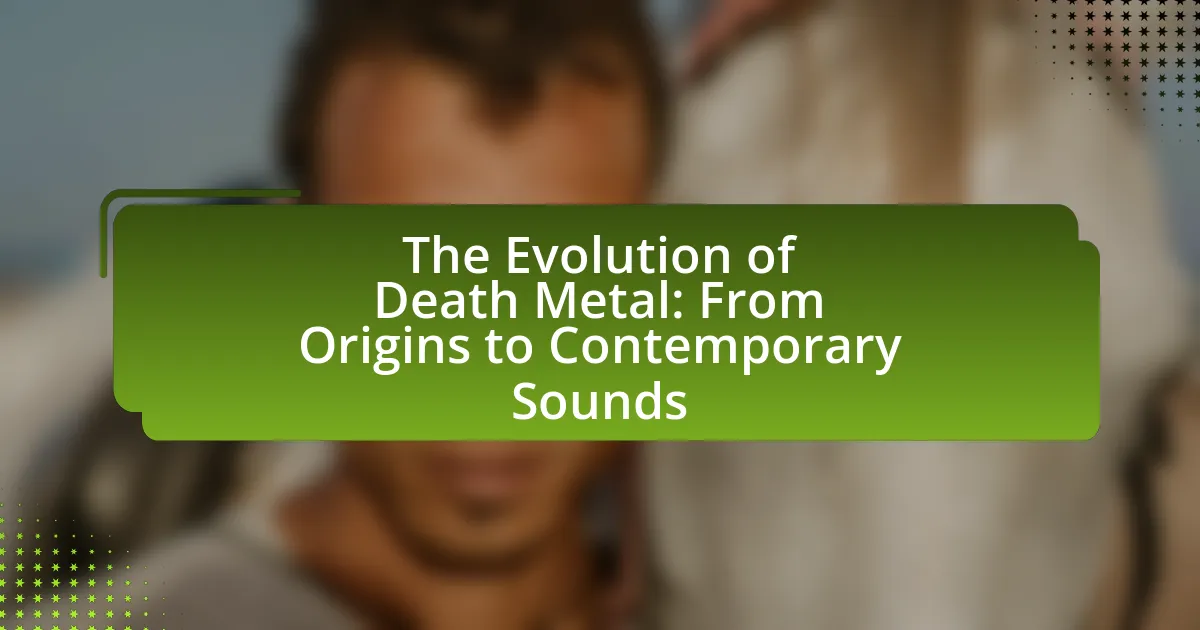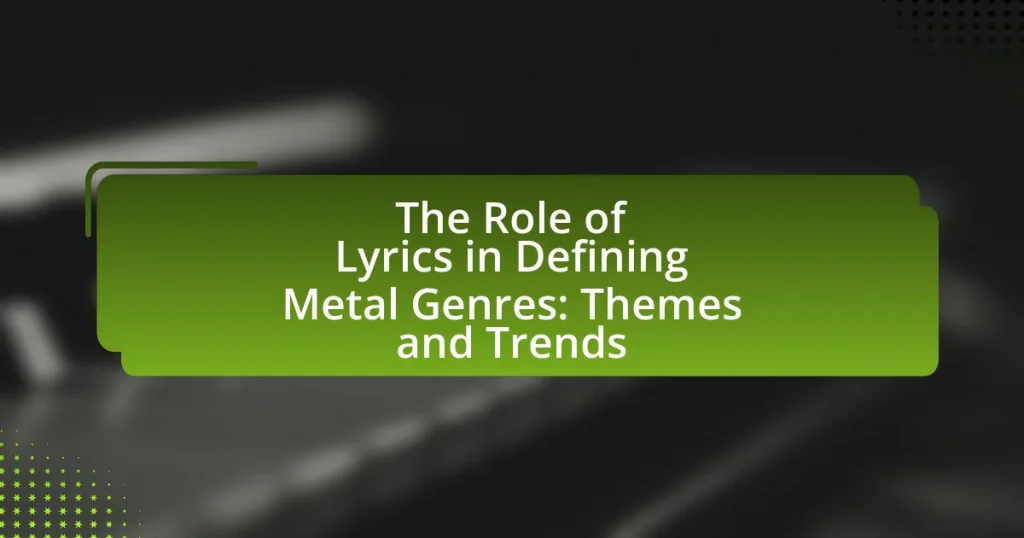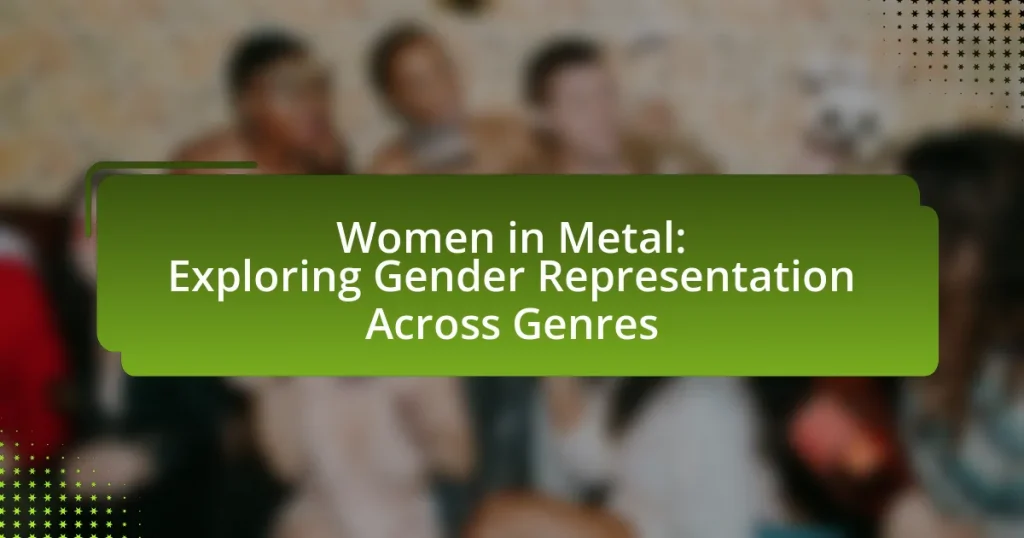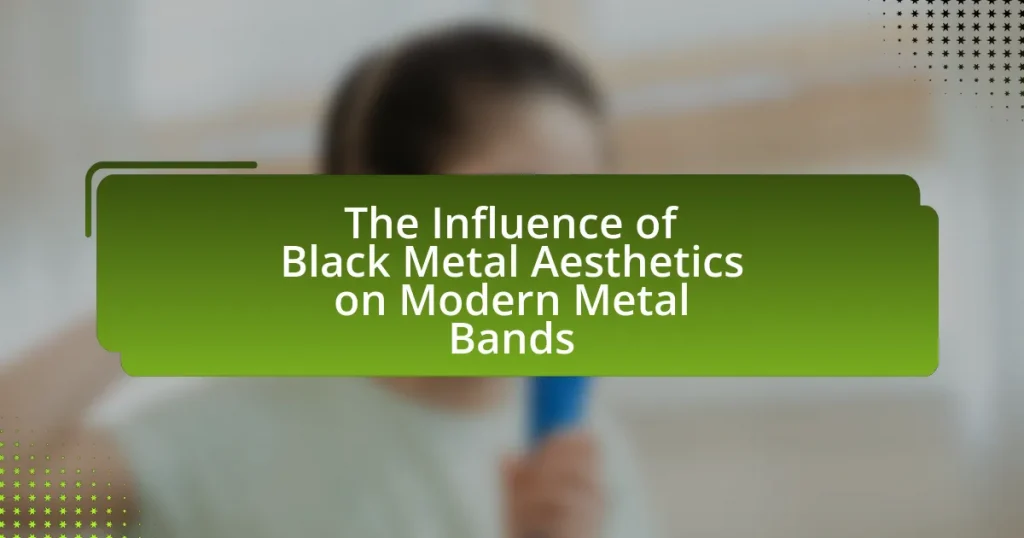Death metal is a subgenre of heavy metal music known for its aggressive sound, deep growling vocals, and complex guitar riffs, evolving from thrash and black metal in the mid-1980s. Pioneering bands such as Death and Possessed laid the groundwork for the genre, which gained popularity in the 1990s with the emergence of technical and melodic elements. The article explores the defining characteristics of death metal, its historical influences, key milestones in its evolution, and the diversification into various subgenres. Additionally, it examines the current state of death metal, the impact of technology and social media, and the trends shaping its future, highlighting the genre’s adaptability and ongoing relevance in contemporary music culture.
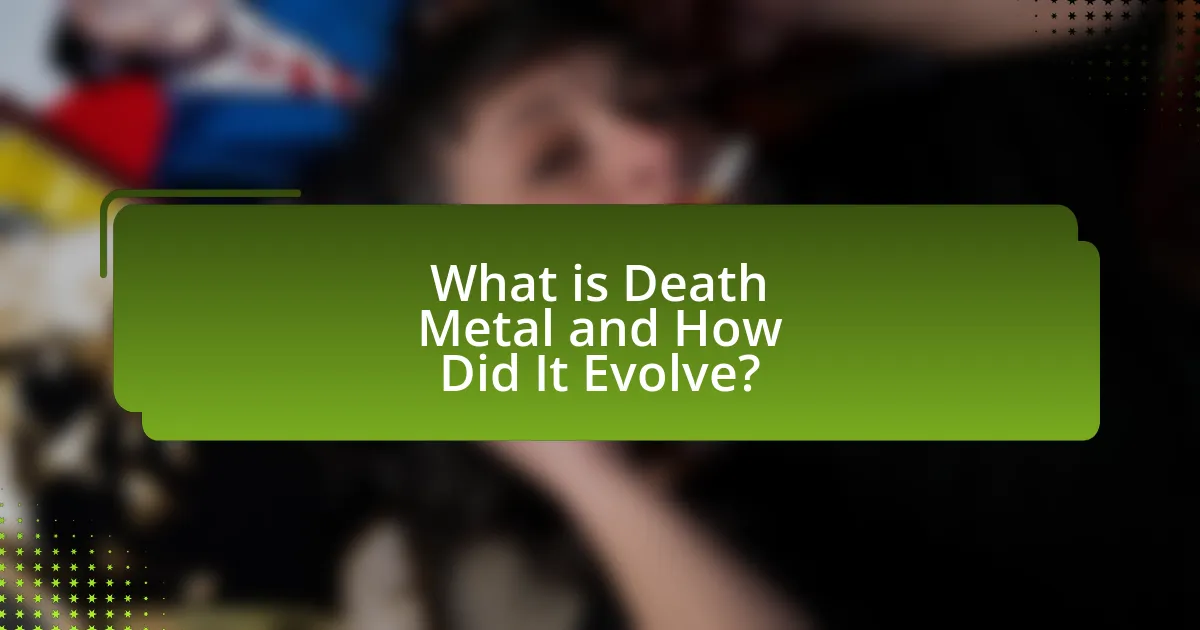
What is Death Metal and How Did It Evolve?
Death metal is a subgenre of heavy metal music characterized by its aggressive sound, deep growling vocals, and complex guitar riffs. It evolved in the mid-1980s, emerging from the thrash metal and black metal scenes, with bands like Death and Possessed pioneering its distinctive style. The genre gained popularity through the 1990s, with the introduction of technical and melodic elements by bands such as Cannibal Corpse and Opeth, leading to various substyles like melodic death metal and brutal death metal. The evolution of death metal reflects a continuous innovation in musical complexity and thematic exploration, solidifying its place in the broader heavy metal landscape.
What are the defining characteristics of Death Metal?
Death Metal is characterized by its aggressive sound, complex song structures, and thematic content that often explores death, violence, and the macabre. The genre typically features heavily distorted guitars, deep growling vocals, and fast-paced drumming, which contribute to its intense auditory experience. Additionally, Death Metal often incorporates intricate guitar solos and time signature changes, showcasing technical proficiency. The lyrical themes frequently delve into horror, existentialism, and social commentary, distinguishing it from other metal genres. These characteristics have been consistently observed in seminal Death Metal bands such as Death and Cannibal Corpse, which have influenced the genre’s evolution since the 1980s.
How do musical elements differentiate Death Metal from other genres?
Death Metal is differentiated from other genres primarily by its distinctive musical elements, including aggressive guitar riffs, complex song structures, and guttural vocal styles. The genre typically features heavily distorted guitars played in a fast, palm-muted style, which creates a dense and powerful sound. Additionally, Death Metal often employs intricate drumming techniques, such as blast beats and rapid double bass drumming, which contribute to its intensity. The lyrical themes frequently explore darker subjects, including death, violence, and existentialism, setting it apart from genres that may focus on more mainstream or lighter themes. These elements collectively establish Death Metal’s unique identity within the broader metal genre.
What lyrical themes are commonly found in Death Metal?
Lyrical themes commonly found in Death Metal include death, violence, horror, and existentialism. These themes often explore graphic depictions of mortality, the macabre, and the human condition, reflecting a fascination with the darker aspects of life. For instance, many Death Metal songs delve into topics such as decay, suffering, and the afterlife, which are prevalent in the genre’s lyrics. The use of vivid imagery and complex narratives serves to evoke strong emotional responses, reinforcing the genre’s intensity and thematic depth.
What historical influences shaped the origins of Death Metal?
The origins of Death Metal were shaped by several historical influences, primarily rooted in the evolution of heavy metal and punk rock. The genre emerged in the mid-1980s, drawing from the aggressive sound of bands like Black Sabbath and Motörhead, which established the heavy metal foundation. Additionally, the fast tempos and raw energy of punk rock bands such as the Ramones and Dead Kennedys contributed to the development of Death Metal’s intensity.
Furthermore, the early Death Metal scene was influenced by the emergence of thrash metal bands like Slayer and Metallica, which introduced faster rhythms and more complex song structures. The lyrical themes of Death Metal, often focusing on death, horror, and existentialism, were also inspired by horror films and literature, reflecting a cultural fascination with the macabre. These combined influences created a distinct sound characterized by growled vocals, intricate guitar riffs, and blast beat drumming, solidifying Death Metal’s place in the heavy music landscape.
Which genres contributed to the development of Death Metal?
Death Metal developed primarily from Thrash Metal, Black Metal, and Doom Metal. Thrash Metal’s fast tempos and aggressive guitar riffs laid the groundwork for Death Metal’s intensity. Black Metal contributed its dark themes and vocal styles, while Doom Metal influenced the slower, heavier aspects of the genre. These genres collectively shaped Death Metal’s signature sound, characterized by complex song structures, deep growling vocals, and intricate guitar work.
Who were the pioneering bands that defined the early sound of Death Metal?
The pioneering bands that defined the early sound of Death Metal include Death, Possessed, and Morbid Angel. Death, formed in 1983, is often credited with creating the genre through their album “Scream Bloody Gore,” which showcased aggressive guitar riffs and growled vocals. Possessed, with their 1985 album “Seven Churches,” introduced themes of horror and brutality, solidifying the genre’s identity. Morbid Angel, emerging in the late 1980s, further developed the sound with their album “Altars of Madness,” which incorporated complex song structures and technical musicianship. These bands collectively laid the groundwork for Death Metal, influencing countless artists and shaping the genre’s evolution.

How Did Death Metal Develop Through the Decades?
Death metal developed through the decades by evolving from early heavy metal and thrash influences in the 1980s to a diverse range of subgenres by the 2020s. In the 1980s, bands like Death and Possessed pioneered the genre, incorporating growled vocals, complex guitar riffs, and dark themes. The 1990s saw the emergence of technical death metal with bands like Cynic and Atheist, emphasizing intricate musicianship and progressive elements. By the 2000s, deathcore emerged, blending death metal with hardcore punk, exemplified by bands like Whitechapel. In the 2010s and 2020s, the genre continued to diversify, with influences from black metal, doom, and even jazz, leading to a rich tapestry of sounds and styles within death metal. This evolution reflects the genre’s adaptability and the musicians’ desire to push creative boundaries.
What were the key milestones in the evolution of Death Metal?
The key milestones in the evolution of Death Metal include the genre’s emergence in the mid-1980s, the release of pivotal albums, and the establishment of subgenres. The genre originated with bands like Death and Possessed, whose 1985 album “Seven Churches” is often credited as one of the first Death Metal records. In 1991, Death’s “Human” showcased technical proficiency and complex song structures, influencing countless bands. The 1990s saw the rise of subgenres such as Melodic Death Metal, exemplified by Gothenburg bands like In Flames and At the Gates, which introduced melodic elements to the genre. The 2000s brought further diversification, with bands like Nile incorporating elements of Middle Eastern music and technical death metal bands like Necrophagist pushing the boundaries of musicianship. These milestones collectively shaped Death Metal into a diverse and evolving genre.
How did the 1990s impact the popularity of Death Metal?
The 1990s significantly increased the popularity of Death Metal through the emergence of influential bands and the expansion of the genre’s audience. Key bands such as Death, Cannibal Corpse, and Morbid Angel released critically acclaimed albums during this decade, which helped to solidify Death Metal’s presence in the mainstream music scene. The 1991 release of Death’s “Human” and Cannibal Corpse’s “Butchered at Birth” showcased technical proficiency and complex song structures, attracting a wider fan base. Additionally, the rise of music festivals and the growth of independent record labels facilitated the distribution of Death Metal, further enhancing its visibility and appeal. By the end of the decade, Death Metal had established itself as a prominent subgenre within the heavy metal community, evidenced by increased album sales and dedicated fan events.
What role did underground scenes play in the genre’s growth?
Underground scenes were crucial in the growth of death metal by providing a platform for emerging bands to develop their sound and gain exposure. These scenes fostered a sense of community and collaboration, allowing musicians to share ideas, techniques, and influences that shaped the genre. For instance, the early 1990s saw the rise of independent record labels and fanzines that promoted underground bands, leading to the proliferation of influential albums like Death’s “Scream Bloody Gore” and Morbid Angel’s “Altars of Madness.” This grassroots support helped establish a dedicated fan base and facilitated the genre’s evolution, ultimately leading to its mainstream recognition.
How did Death Metal diversify into subgenres?
Death Metal diversified into subgenres primarily through the incorporation of various musical influences and stylistic innovations. As the genre evolved in the late 1980s and early 1990s, bands began to experiment with elements from other genres such as grindcore, black metal, and even progressive rock, leading to distinct subgenres like melodic death metal, technical death metal, and brutal death metal. For instance, the emergence of melodic death metal in Sweden, characterized by harmonized guitar melodies and a more accessible sound, was exemplified by bands like In Flames and Dark Tranquillity. Additionally, technical death metal, which emphasizes complex song structures and musicianship, was popularized by bands such as Death and Atheist. This diversification reflects the genre’s adaptability and the musicians’ desire to push creative boundaries, resulting in a rich tapestry of sounds within the Death Metal umbrella.
What are the main subgenres of Death Metal and their characteristics?
The main subgenres of Death Metal include Old School Death Metal, Technical Death Metal, Melodic Death Metal, Brutal Death Metal, and Death-Doom. Old School Death Metal is characterized by its raw sound and simple song structures, often featuring growled vocals and heavy guitar riffs, exemplified by bands like Death and Obituary. Technical Death Metal emphasizes complex song structures, intricate guitar work, and advanced musicianship, with bands such as Necrophagist and Origin showcasing these traits. Melodic Death Metal incorporates melodic elements and harmonies, often blending with other genres, as seen in the works of In Flames and At the Gates. Brutal Death Metal focuses on extreme aggression, fast tempos, and guttural vocals, with bands like Cannibal Corpse and Suffocation representing this style. Death-Doom combines elements of Death Metal and Doom Metal, characterized by slower tempos and a heavier atmosphere, with bands like Autopsy and Paradise Lost exemplifying this subgenre. Each subgenre contributes to the overall diversity and evolution of Death Metal.
How did regional scenes influence the sound of Death Metal?
Regional scenes significantly influenced the sound of Death Metal by shaping its musical characteristics and lyrical themes. For instance, the Florida Death Metal scene, exemplified by bands like Death and Obituary, introduced a more melodic and technical approach, characterized by intricate guitar work and complex song structures. In contrast, the Swedish scene, represented by bands such as Entombed and Dismember, developed a distinct sound known as “Swedish Death Metal,” which featured a heavier, more aggressive tone and a focus on groove, often incorporating elements of punk. These regional variations contributed to the genre’s diversity, as different local influences, including cultural backgrounds and musical traditions, shaped the bands’ styles and approaches to songwriting. The geographical differences in sound are evident in the production techniques and instrumentation used, with Florida bands often favoring a polished sound, while Swedish bands embraced a rawer aesthetic.

What is the Current State of Death Metal?
The current state of death metal is characterized by a diverse range of subgenres and a global resurgence in popularity. Bands such as Blood Incantation and Revocation are pushing the boundaries of the genre with innovative sounds and complex compositions, while established acts like Cannibal Corpse and Morbid Angel continue to maintain a strong presence in the scene. The genre has also seen a rise in female musicians and bands, contributing to its evolution and expanding its audience. Festivals dedicated to death metal, such as Maryland Deathfest, have grown in attendance, indicating a robust community and interest in the genre. Additionally, streaming platforms have facilitated the discovery of both new and classic death metal, further solidifying its relevance in contemporary music culture.
How has technology influenced contemporary Death Metal?
Technology has significantly influenced contemporary Death Metal by enhancing production quality and enabling innovative sound design. Digital audio workstations (DAWs) allow musicians to record, edit, and mix tracks with precision, resulting in a polished final product that was difficult to achieve in earlier eras. Additionally, advancements in guitar modeling software and plugins provide musicians with a vast array of tones and effects, facilitating unique soundscapes that define modern Death Metal. The rise of social media and streaming platforms has also transformed how bands promote their music and connect with fans, leading to a more global reach and diverse influences within the genre.
What role do social media and streaming platforms play in the genre today?
Social media and streaming platforms are crucial in shaping the contemporary death metal genre by facilitating artist exposure and audience engagement. These platforms allow musicians to share their work directly with fans, bypassing traditional gatekeepers like record labels. For instance, Spotify reported that over 60% of listeners discover new music through playlists, which often feature emerging death metal bands. Additionally, social media platforms like Instagram and Facebook enable artists to connect with their audience, promote tours, and share behind-the-scenes content, fostering a dedicated fanbase. This direct interaction has led to increased visibility for niche genres like death metal, contributing to its growth and evolution in the modern music landscape.
How have production techniques evolved in modern Death Metal?
Production techniques in modern Death Metal have evolved significantly through advancements in technology and changes in artistic direction. The introduction of digital recording and editing software has allowed for greater precision in sound manipulation, enabling bands to achieve a polished and intricate sound that was difficult to attain with analog methods. Additionally, the use of multi-tracking and layering techniques has become commonplace, allowing for complex arrangements and the incorporation of various instrumental elements.
Furthermore, modern Death Metal often employs advanced mixing techniques, such as dynamic range compression and equalization, to enhance the clarity and impact of each instrument. This evolution is evidenced by the production quality of albums from bands like Obscura and Death, which showcase a high level of technical proficiency and sonic depth compared to earlier recordings. The shift towards a more refined production style reflects the genre’s growth and the influence of other musical styles, contributing to a broader appeal and a more diverse sound palette within the Death Metal genre.
What are the current trends and future directions in Death Metal?
Current trends in Death Metal include the incorporation of diverse musical elements, such as progressive and atmospheric influences, as well as a growing emphasis on technical proficiency and complex song structures. Bands like Archspire and Obscura exemplify this trend by blending traditional Death Metal with progressive and technical elements, pushing the genre’s boundaries. Future directions may see further experimentation with genres like black metal and electronic music, as well as an increased focus on lyrical themes that address contemporary social issues, reflecting the genre’s adaptability and relevance in modern music culture.
Which bands are leading the contemporary Death Metal scene?
The leading bands in the contemporary Death Metal scene include Death, Cannibal Corpse, and Obituary. These bands have significantly influenced the genre, with Death being credited for pioneering the style in the late 1980s and early 1990s, particularly with their album “Symbolic.” Cannibal Corpse, known for their graphic lyrics and aggressive sound, has maintained a strong presence since their formation in 1988, with albums like “Tomb of the Mutilated” solidifying their status. Obituary, recognized for their heavy riffs and growled vocals, has been a staple since their debut album “Slowly We Rot” in 1989. Their continued relevance and impact on the genre demonstrate their leadership in the contemporary Death Metal scene.
How is Death Metal being received by new audiences today?
Death Metal is being increasingly embraced by new audiences today, particularly through the rise of digital platforms and social media. Streaming services like Spotify and YouTube have made Death Metal more accessible, allowing younger listeners to discover the genre alongside other musical styles. Additionally, the genre’s incorporation of diverse influences and collaborations with artists from various genres has broadened its appeal. For instance, bands like Blood Incantation and Rivers of Nihil have gained popularity by blending elements of progressive rock and atmospheric music with traditional Death Metal, attracting a wider fan base. This trend is supported by data showing a significant increase in Death Metal playlists and listener engagement on streaming platforms over the past few years.
What can fans do to support the Death Metal community?
Fans can support the Death Metal community by attending live shows and purchasing merchandise from their favorite bands. Attending concerts not only boosts ticket sales but also fosters a sense of community among fans and artists. Additionally, buying merchandise directly supports the bands financially, allowing them to continue creating music. According to a 2020 survey by the Music Industry Research Association, live performances and merchandise sales account for over 70% of a band’s income, highlighting the importance of fan participation in sustaining the genre.
